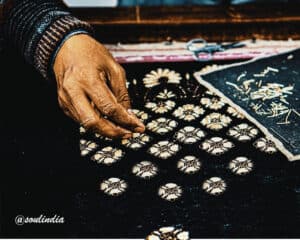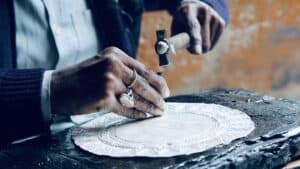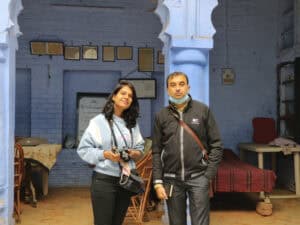If you are a history enthusiast and love exploring heritage sites, a visit to Lucknow—the city of Nawabs—should be on your list. The Lucknow Heritage Walk is an enriching experience that offers a deep dive into the city’s illustrious past. This guided tour not only enhances your knowledge about Lucknow but also provides an immersive experience, allowing you to relive the Nawabi era for a few hours.
As someone born and raised in Lucknow, this heritage walk gave me a newfound appreciation for my city. The tour starts from Lal Pul and covers historical landmarks, including Tila Wali Masjid, Bara Imambara, Gol Darwaja, Chowk Bazaar, Phool Wali Gali, and ends at Akbari Darwaja.
The Journey Begins: Tila Wali Masjid
Our journey began at 7 am on a misty, cold morning at Tila Wali Masjid. The mosque looked surreal in the morning fog. Here, we met Atif, our knowledgeable tour guide, who has a deep passion for history, having grown up with a professor father immersed in historical studies. The Tila Wali Masjid in Lucknow is an architectural gem with hidden artistic treasures. Built during the Mughal Emperor Aurangzeb’s reign, the mosque features intricate Persian paintings, showcasing vibrant colors and detailed patterns. During the British colonial period, these paintings were whitewashed, concealing them for years. About 15 years ago, a restoration effort revealed these long-hidden artworks, restoring the mosque’s original splendor. This discovery has enhanced the mosque’s historical and aesthetic value, reigniting interest in preserving Lucknow’s cultural heritage.
Bara Imambara: A Marvel of Architecture
The next stop was Bara Imambara, a stunning example of Mughal architecture. The Imambara is not just a religious site but also a testament to the architectural brilliance of the Nawabs. Walking through its corridors and chambers, you can’t help but marvel at the grandeur and the stories these walls hold. Atif made the whole experience even more interesting by adding his own perspective to facts and stories of the Nawabs. For instance, he explained, “आप अफोर्ड भी कर सकते हो तो भी ये अजीब लगेगा अगर आप अपने बॉस से बड़ी और एक्सपेंसिव कार लो”, offering an interesting take on why most of the monuments in Lucknow were built using Lakhori bricks and local materials, and not marble, as the Nawabs were subordinates of the Mughal Emperor.
Gol Darwaja: A Taste of History
As we approached Gol Darwaja, we indulged in “Nimish” or “Malai Makkhan,” a fluffy, sweet delicacy made especially in the winter. Atif mentioned that this 400-year-old shopping hub offers everything between its two gates. The lower sections house shops, while the upper sections, which used to have “kothas” of courtesans, were historically where royals sent their younger generations to learn Tehzeeb, culture, singing, and dancing. Inside Gol Darwaja, we explored old shops selling Zari work, Chikankari, hand-block prints, and silverware. The craftsmanship and artistry in these shops reflect Lucknow’s rich artisanal heritage.

Nakkhas Market: A Glimpse into the Nawabi Era
Nakkhas Market transported us back to the Nawabi era, thanks to Atif’s insightful narration. He explained that Wajid Ali Shah’s Khajanchi (treasurer) established this circular bazaar for artisans. Here, you can find silver embroiderers, silverware artisans, and hand-block artists. A silver craftsman proudly showed us shoes made entirely of pure silver, with the intricate work and the craftsman’s humble demeanor leaving us in awe. This market is a treasure trove of historical artifacts and traditional crafts, embodying Lucknow’s rich cultural heritage.

The Itra Craftsman: Essence of Lucknow
Near Nakkhas Market, we visited an itra (perfume) shop, where we met Imran Ahmed ji,an itra craftsman, who truly embodied the spirit of Lucknow. Conversing with him gave us a deeper understanding of what Lucknow means. The organic itra available here is a fragrant souvenir of your journey.
Firangi Mahal: A Historical Haven
The tranquil blue walls of Firangi Mahal are steeped in history. One side is decorated with motivational letters from Mahatma Gandhi, invoking patriotism during the non-cooperation movement. The other side features a “Farman of Aurangzeb” from when the Mahal was built. Although I couldn’t read Aurangzeb’s Farman as it was in Urdu, Gandhi’s letters still evoke feelings of love and pride for the motherland. Firangi Mahal was Gandhi’s favorite place to stay in Lucknow during the non-cooperation movement. Many strategic meetings with personalities like Jawaharlal Nehru, Sarojini Naidu, and Abdul Kalam Azad took place under this Mahal’s roof. In the 18th century, this Mahal was considered an influential Islamic institute.

The Bustling Chowk Bazaar and Phool Wali Gali
Chowk Bazaar is another highlight of the walk, bustling with life and rich with history. Nearby Phool Wali Gali is known for its flower shops, interestingly providing blooms for temples and courtesan buildings alike, as both were in proximity.
The Grand Finale: Akbari Darwaja
The walk concludes at Akbari Darwaja, leaving you with a sense of awe and a deeper appreciation for Lucknow’s heritage. Each site on the walk offers a unique glimpse into the city’s past, from its architectural wonders to its traditional crafts and vibrant markets.
Practical Tips for the Heritage Walk
For those interested in taking this journey through history, here are some tips:
- Allocate at least 3-4 hours to fully explore the sites.
- Food enthusiasts can opt for a separate food walk curated for connoisseurs.
- For a guided experience, contact Atif, who is highly recommended for both heritage and food walks. His contact number is available upon request.
The Lucknow Heritage Walk is not just a tour; it’s a journey through time that allows you to experience the grandeur and charm of the Nawabi era. Whether you are a local or a visitor, this walk is sure to leave you with lasting memories and a deeper connection to Lucknow’s rich history.